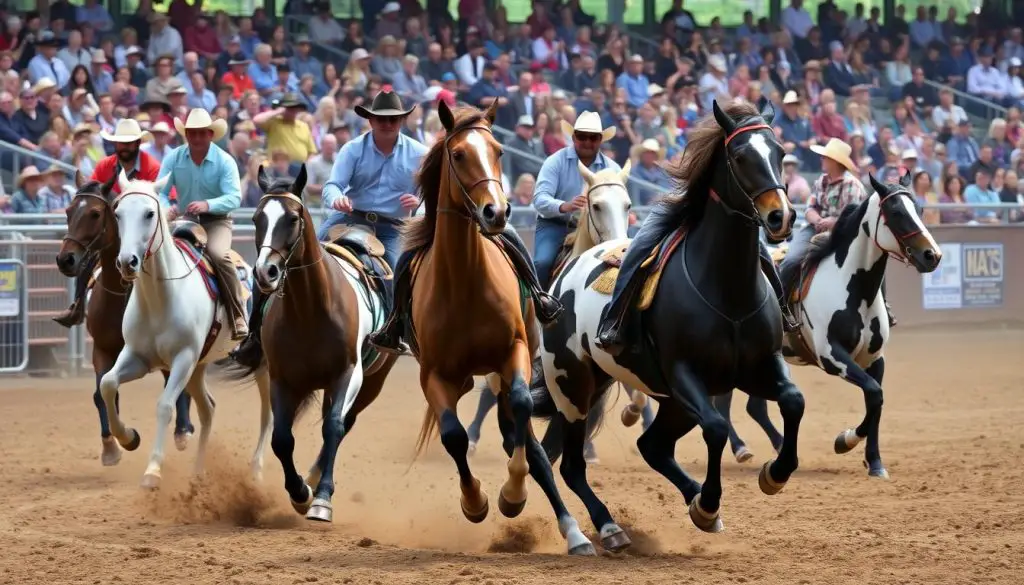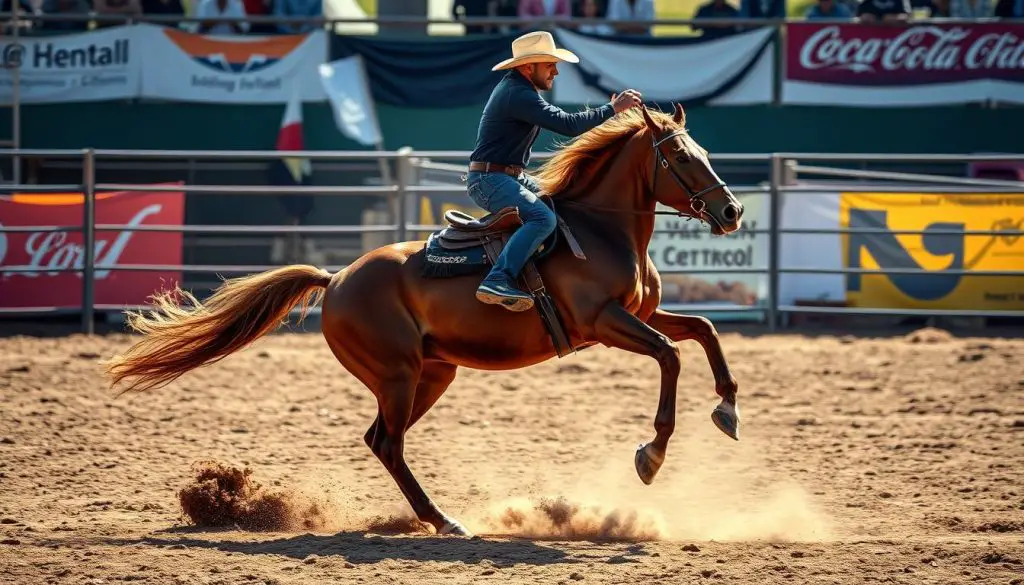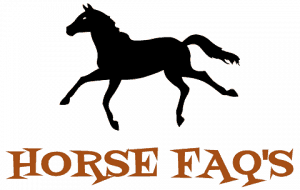Have you ever wondered what makes a horse truly suited for the thrilling world of Western riding? As we delve into the realm of The Best Breeds for Western Riding Disciplines, we’re set to explore the unique characteristics of iconic breeds like the Quarter Horses, Appaloosas, Paint Horses, Mustangs, and Ranch Horses. Each of these breeds possesses attributes that enhance their capabilities, from rodeos to ranch work and competitive events. Their historical significance within cowboy culture adds a fascinating layer to their already impressive narratives.
Key Takeaways
- Quarter Horses are renowned for their speed and agility, making them ideal for various Western disciplines.
- Appaloosas are recognized for their unique coat patterns and versatility across multiple riding styles.
- Paint Horses blend beauty with athleticism, excelling in rodeos and performance events.
- Mustangs embody the wild spirit of the West, showcasing resilience and adaptability.
- Ranch Horses are essential workhorses, prized for their reliability in high-pressure environments.
Introduction to Western Riding
Western riding represents a unique blend of history, tradition, and skill, deeply rooted in the cowboy culture. This riding style finds its origins in the European exploration of the Americas, marked by the influence of Spanish horses that reintroduced mounted traditions. Over the years, it evolved to suit the practical needs of working cowboys, leading to the development of various riding disciplines.
In modern times, Western riding encompasses several popular disciplines, including barrel racing, reining, and ranch riding. Each discipline emphasizes different skills and techniques, showcasing the versatility and adaptability of Western horses. Western riding gear, like saddles and bridles, has also transformed to enhance both performance and comfort, catering to long hours in the saddle.
The structure of Western riding prioritizes both the rider’s and horse’s comfort, with an emphasis on stockier builds and powerful hindquarters. Breeds such as the American Quarter Horse, known for being the most popular in the United States, exemplify the qualities sought after in Western riding. Other notable breeds include the American Paint Horse and Appaloosa, each excelling in different areas of riding disciplines.
As the Western riding community expands, it continues to foster a welcoming environment for riders of all skill levels, allowing more enthusiasts to engage with this celebrated aspect of cowboy culture.
Understanding Western Riding Disciplines
Western riding encompasses a variety of disciplines, each with its own unique challenges and skills. From the thrill of barrel racing to the precision required in reining, these disciplines require dedicated training and a solid understanding of horse and rider dynamics. Exploring the specifics of each discipline helps potential riders choose the right path and equipment.
Overview of Common Disciplines
Barrel racing stands out as one of the fastest-paced Western riding disciplines, with average run times of just 15 seconds. This competition format is unique as it is exclusively for women at the professional level. Riders navigate a cloverleaf pattern around three barrels, showcasing both speed and agility.
Reining tests a rider’s ability to guide their horse through a pre-set pattern, emphasizing control and smooth execution. Judges look for finesse in the performance, rewarding fluidity and precision. Other notable disciplines include cutting, where the horse’s capability to work cattle is evaluated, and trail riding, which challenges horse and rider to tackle a course filled with natural obstacles.
Importance of Selecting the Right Breed
Selecting horse breeds suitable for these Western riding disciplines is crucial. Breeds such as Quarter Horses, Paints, and Appaloosas are favored for their strong builds and calm temperaments. These breeds possess the agility and stamina necessary for success in events like barrel racing and reining. By understanding the strengths of different breeds, riders can enhance their performance, whether competing in timed events or navigating the complexities of cattle work.
The Best Breeds for Western Riding Disciplines
When considering the best breeds for Western riding, certain characteristics define the ideal Western horses. These horses are known for their calm temperament, physical strength, and remarkable agility. Such qualities ensure they excel across various Western riding disciplines, enhancing horses’ performance and rider enjoyment.
Characteristics of Ideal Western Horses
Many features contribute to a horse’s ability to thrive in Western riding. The following traits stand out:
- Temperament: A calm and easy-going nature is vital, allowing horses to remain focused and responsive during rides.
- Physical Build: Stocky finishes and powerful muscles provide the strength necessary for events like barrel racing, which typically sees runs averaging around 15 seconds.
- Agility: Quick reflexes play a crucial role in disciplines such as cutting, where horses anticipate and react to cow movements.
- Cow Sense: Understanding cattle behavior greatly enhances a horse’s efficiency, making it an essential trait for ranch work.
- Versatility: Ideal Western horses perform exceptionally well in numerous events, from trail riding to rodeo competitions, proving their adaptability within the discipline.
These characteristics assure riders that their mounts are well-suited for Western riding, meeting the demands of both casual and competitive environments.
| Trait | Description |
|---|---|
| Temperament | Calm and easy-going nature for better focus |
| Physical Build | Strong and muscular for strength in fast-paced events |
| Agility | Quick reflexes for disciplines like cutting |
| Cow Sense | Ability to understand and anticipate cattle behavior |
| Versatility | Success across various Western riding events |
Quarter Horses: The Quintessential Western Mount
The American Quarter Horse stands out as a premier choice for Western riding, known for its remarkable attributes that cater to a variety of disciplines. The strengths for Western riding featured in this breed provide a strong foundation for both competitive and recreational pursuits. These horses possess exceptional speed, agility, and the necessary instincts for working cattle, making them invaluable companions in various riding environments.
Strengths and Skills
Quarter Horses exhibit unique strengths that make them excel in numerous Western disciplines. Their incredible speed over short distances is unparalleled and plays a crucial role in events such as barrel racing and cutting. Additionally, these horses are equipped with the agility needed for quick turns and sudden stops, making them ideal for ranch work and competitive settings.
- Speed: Quarter Horses dominate in speed competitions, showcasing their prowess over short distances.
- Agility: Their compact, muscular frames enhance agility, crucial for navigating tight turns and executing precise movements.
- Cow Sense: Descendants from reputable bloodlines such as Doc Bar and Peppy San Badger are renowned for their innate understanding of cattle.
Versatility in Disciplines
The versatility of Quarter Horses is remarkable. They excel not only in traditional ranch activities but also in various competitive disciplines, making them a favorite among riders of all skill levels. This breed’s adaptability extends to dressage, ranch riding, and trail challenges, exemplifying their ability to thrive in diverse scenarios.
| Discipline | Key Strengths |
|---|---|
| Barrel Racing | Speed, quick turns |
| Cutting | Cow sense, agility |
| Ranch Work | Endurance, quick reflexes |
| Dressage | Balance, refinement, adaptability |
Quarter Horses continue to impress with their versatility, proven by their achievements across a spectrum of events. From ranch riding to extreme trail challenges, these remarkable horses embody the spirit and adaptability that every Western rider seeks.
Appaloosas: Unique and Reliable Companions
Appaloosas are remarkable horses, widely recognized for their distinctive features and faithful companionship. Known for their striking spotted coats and striking presence, these horses bring a combination of beauty and reliability to Western riding disciplines. Breeders initially developed the breed through the Nez Perce tribe, who valued them for their endurance and intelligence, qualities that remain prevalent today.
Distinctive Features
The Appaloosa stands out due to its impressive distinctive features. Their mottled skin provides protection against harsh sunlight, while the striped hooves contribute to their unique appearance. Often measuring between 14.2 and 16 hands high, Appaloosas are muscular and athletic. Their wide variety of coat colors and patterns, including the iconic leopard pattern, are a testament to their diverse genetic influences that include Arabian, Quarter Horse, and Thoroughbred lines.
Endurance and Adaptability
Notable for their endurance and adaptability, Appaloosas excel in various disciplines such as endurance riding, dressage, and Western performance events. Their natural intelligence and trainability make them suitable for riders of all levels, although they thrive with experienced handlers who use calm, patient training methods. Appaloosas require regular exercise to maintain their robust builds, ensuring they remain physically fit and mentally stimulated.
With their gentle demeanor and ability to connect with people, Appaloosas make excellent therapy horses, further proving their versatility. These traits combined with their striking looks have cemented the Appaloosa’s place as a beloved breed in the world of Western riding.
Paint Horses: Beauty Meets Performance
Paint Horses are remarkable for their striking appearance and impressive athletic abilities. This breed captivates enthusiasts with a blend of colorful coats and strong physical capabilities, making them ideal candidates for various equestrian disciplines. As they shine in popular events, their contributions extend far beyond looks.
Athletic Abilities
Paint Horses are recognized for their versatility in disciplines such as Western pleasure, barrel racing, and reining. These breeds typically measure between 14.2 and 16 hands, showcasing a sturdy build that supports their agility and endurance. Various coat patterns, including Overo, Tobiano, and Tovero, reflect the breed’s unique characteristics while their well-muscled physique enables them to compete effectively across different events.
Popularity in Rodeos and Shows
Paint Horses hold a significant presence in rodeos and Western shows, making a name for themselves in competitions around the country. The breed’s calm demeanor and adaptability allow both beginners and experienced riders to enjoy their company. As one of the largest equine breed registries globally, the American Paint Horse Association (APHA) champions the breed’s success, ensuring their appreciation continues to grow.

Mustangs: The Wild Spirit
Mustangs embody the wild spirit of the American West, representing a unique blend of history and inherent traits. Their heritage began with horses introduced by the Spaniards in the 16th century, which mixed with indigenous wild horse populations, leading to the resilient breed we see today. Currently, around 100,000 free-ranging Mustangs roam the western United States, demonstrating their adaptability and endurance in diverse ecosystems.
Heritage and Characteristics
The initial development of Mustangs drew from various equine bloodlines, including Andalusian and Arabian horses, creating a breed that showcases strength and stamina. These horses typically measure between 1.40 and 1.50 meters, appearing in a spectrum of colors such as jet black, chestnut, and bay. Known for their intelligence, cheerfulness, and liveliness, they exhibit loyalty and protectiveness towards their herd. Though often wary of humans, Mustangs demonstrate remarkable independence and resilience.
Physical attributes contribute to their reputation as exceptional long-distance competitors. Mustangs thrive in challenging conditions thanks to their muscular build, enabling them to endure extreme weather and maintain speed. Taming a Mustang requires patience and trust, as they must learn to adapt to human interaction. Their diet consists mainly of grasses and herbs, necessitating ample space and water to sustain their robust health.
| Characteristic | Description |
|---|---|
| Height | 1.40 to 1.50 meters |
| Colors | Jet black, chestnut, rosillo, bay, snow white |
| Intelligence | High; known for independence and adaptability |
| Diet | Herbs, grass, hay, and cereals |
| Water Requirement | 20 to 60 liters daily |
| Population | Approximately 100,000 free-ranging |
Ranch Horses: The Workhorses of the West
Ranch horses play a pivotal role in the Western lifestyle. These workhorses are essential for effective cattle management and various ranch activities. Built with sturdy bodies and strong legs, ranch horses are designed to handle demanding tasks while maintaining a calm demeanor. Their versatility allows them to excel in different roles on the ranch, making them invaluable partners for ranchers.
Some notable ranch horse breeds offer outstanding qualities to support cattle management. For instance, Driftwood, a top match racehorse, transitioned into a famous rope horse, producing exceptional descendants. Two Eyed Jack, a sorrel stallion, is recognized for a remarkable number of progeny, contributing to the development of versatile and well-disposed horses, particularly in Nebraska and the Midwest.
Joe Hancock, another renowned figure, is celebrated for producing hardworking horses favored by rodeo competitors and ranchers alike. Meanwhile, Doc Bar is known for his cutting-horse legacy, showcasing cow sense and athleticism that appealed to many ranch activities.
A look at the statistics highlights the immense contributions of these great horses:
| Horse Name | Foaled | Key Achievements | Descendants |
|---|---|---|---|
| Driftwood | 1932 | Top match racehorse & famous rope horse | Produced Poker Chip Peake, Woodwind |
| Two Eyed Jack | 1961 | Sired 1,416 foals, 149 AQHA Champions | Popular in Nebraska and Midwest |
| Joe Hancock | 1923-1925 | Retired undefeated match-race career | Known for hardworking descendants |
| Doc Bar | N/A | Excelled in halter, cutting-horse dynasty | Dominated cutting competitions |
| Little Peppy | 1974 | NCHA Futurity winner | Sired earners exceeding $25 million |
The adaptability of ranch horses encompasses various breeds, ensuring they can thrive under diverse conditions. With their exceptional skills and unwavering dedication, these horses continue to symbolize the heart of ranch life.
Cutting Horses: Precision and Agility
Cutting horses stand out for their exceptional precision and agility, making them integral to modern ranching and competitive events. These horses excel at separating cattle from a herd, showcasing their strong instincts and remarkable athletic abilities. Their innate skills are crucial for success in this demanding equestrian discipline.
Key Traits for Success
To thrive as cutting horses, these equines possess several key traits:
- Strong instinct: An ability to read cattle movements is essential.
- Quick reflexes: Lightning-fast reactions help them maneuver effectively.
- Exceptional physical abilities: Strong hindquarters contribute to their agility.
- Calm demeanor: Remaining composed under pressure aids in precision during cutting.
Training and Techniques
Training cutting horses requires a disciplined approach to develop their natural skills. Effective training techniques include:
- Consistent exposure to cattle helps reinforce their instincts.
- Practice cutting under various conditions improves their adaptability.
- Focused drills enhance speed and responsiveness to rider commands.
- Positive reinforcement encourages confidence and strengthens their bond with the rider.
Success in cutting horse competitions demands a balance of precision and agility. Riders play a vital role, providing clear cues and maintaining a steady presence during the performance. The combination of skilled training methods and the horse’s natural abilities leads to remarkable results in this thrilling discipline.
| Trait | Description |
|---|---|
| Instinct | Ability to effectively read and respond to cattle movements. |
| Reflexes | Quick reactions that facilitate rapid directional changes. |
| Physique | Strong hindquarters that enhance speed and agility. |
| Demeanor | Calm and composed under the stress of competition. |
Reining Horses: The Dance of Control
Reining Horses are central to the Western riding scene, showcasing a unique blend of athleticism and precision. These horses are trained to perform complex maneuvers that require an exceptional level of control, making them some of the most versatile contenders in competitions. Understanding the competition requirements is crucial for both riders and trainers aiming to excel in this captivating discipline.
Requirements for Competition
The requirements for competing with reining horses go well beyond basic riding skills. Each horse must demonstrate remarkable agility, smooth transitions, and flawless execution of intricate patterns. Riders are expected to exhibit a balance of skill, control, and partnership with their horse. The following aspects play a significant role in preparing for competition:
- Training: Consistent practice focusing on spins, slides, and stops is essential for developing the agility needed in reining.
- Fluid Movement: Judges look for smooth transitions and effortless maneuvers, highlighting the need for a horse to be responsive to subtle cues.
- Correct Form: Maintaining proper posture and positioning ensures that both horse and rider can achieve the best performance.
The dynamic nature of reining, often referred to as the “dance of control,” allows riders to showcase their horsemanship while adhering to the evaluation criteria set forth for competitions. Mastering these components determines success in this highly skilled and visually impressive discipline.

Conclusion
As we reflect on the diverse and exciting world of Western riding, it becomes clear that selecting the right breed is essential for success in various disciplines. In this summary of breeds, we explored the standout qualities of Quarter Horses, Appaloosas, Paints, and Mustangs, each bringing unique characteristics that enhance the Western riding experience. Understanding the strengths and skills of these breeds allows riders to make informed decisions, better aligning their horse’s attributes with specific activities.
The importance of a strong partnership between horse and rider cannot be overstated, as it forms the foundation of the rich tapestry of cowboy culture. From the powerful agility of the Quarter Horse in competitive settings to the versatility of Appaloosas across different challenges, each breed offers a special connection that speaks to the heart of Western riding. For those eager to dive deeper into the nuances of horseback riding disciplines, the full exploration of Western riding details not only these breeds but also the artistry and athleticism involved in the sport.
Ultimately, the journey into Western riding is as rewarding as it is challenging, requiring patience, dedication, and an understanding of the unique traits that each breed possesses. With careful consideration and connection, riders can truly embrace the best breeds for Western riding disciplines, fostering a fulfilling and dynamic relationship that withstands the test of time.
